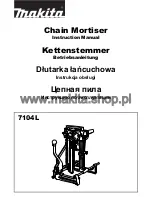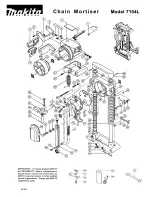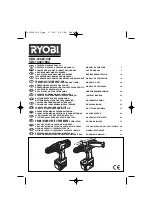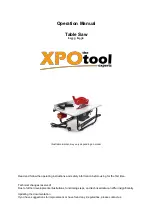
22
EngliSh
Rafter Hook (Fig. A)
(Included with some models)
WARNING:
To reduce the risk of serious personal injury,
do not use the tool's rafter hook to hang the tool from your
body. DO NOT use the rafter hook for tethering or securing
the tool to a person or object during use. DO NOT suspend
tool overhead or suspend objects from the rafter hook.
WARNING:
To reduce the risk of injury from the circular
saw falling on operators or bystanders, make sure it is
supported securely when using the rafter hook, or resting
in a secure and stable location when not in use. Be sure
to keep the area below clear to reduce the risk of the
tool or off‑cut material falling and striking someone or
something below.
Dust Extraction (Fig. DD)
WARNING:
Risk of dust inhalation. To reduce the risk of
personal injury,
ALWAYS
wear an approved dust mask.
A dust extraction port
34
is supplied with your tool.
The dust extraction port allows you to connect the tool
to an external dust extractor, either using the AirLock™
system (DWV9000‑XJ), or a standard 35 mm dust
extractor fitment.
WARNING: ALWAYS
use a vacuum extractor designed
in compliance with the applicable directives regarding
dust emission when sawing wood. Vacuum hoses of most
common vacuum cleaners will fit directly into the dust
extraction outlet.
Cutting (Fig. Y)
WARNING:
Never attempt to use this tool by resting it
upside down on a work surface and bringing the material
to the tool. Always securely clamp the workpiece and
bring the tool to the workpiece, securely holding the tool
with two hands as shown in Fig. Y.
Place the wider portion of the saw base plate on that part of the
work piece which is solidly supported, not on the section that
will fall off when the cut is made. As examples, Fig. Y illustrates
the RIGHT way to cut off the end of a board. Always clamp work.
Don’t try to hold short pieces by hand! Remember to support
cantilevered and overhanging material. Use caution when
sawing material from below.
Be sure saw is up to full speed before blade contacts material
to be cut. Starting saw with blade against material to be cut
or pushed forward into kerf can result in kickback. Push the
saw forward at a speed which allows the blade to cut without
laboring. Hardness and toughness can vary even in the same
piece of material, and knotty or damp sections can put a heavy
load on the saw. When this happens, push the saw more slowly,
but hard enough to keep working without much decrease
in speed. Forcing the saw can cause rough cuts, inaccuracy,
kickback, and over‑heating of the motor. Should your cut begin
to go off the line, don’t try to force it back on. Release the switch
and allow blade to come to a complete stop. Then you can
withdraw the saw, sight anew, and start a new cut slightly inside
the wrong one. In any event, withdraw the saw if you must shift
the cut. Forcing a correction inside the cut can stall the saw and
lead to kickback.
IF SAW STALLS, RELEASE THE TRIGGER AND BACK THE SAW
UNTIL IT IS LOOSE. BE SURE BLADE IS STRAIGHT IN THE CUT AND
CLEAR OF THE CUTTING EDGE BEFORE RESTARTING.
As you finish a cut, release the trigger and allow the blade to
stop before lifting the saw from the work. As you lift the saw,
the spring‑tensioned telescoping guard will automatically close
under the blade. Remember the blade is exposed until this
occurs. Never reach under the work for any reason. When you
have to retract the telescoping guard manually (as is necessary
for starting pocket cuts) always use the retracting lever.
nOTE:
When cutting thin strips, be careful to ensure that small
cutoff pieces don’t hang up on inside of lower guard.
Pocket Cutting (Fig. AA)
WARNING:
Never tie the blade guard in a raised position.
Never move the saw backwards when pocket cutting. This
may cause the unit to raise up off the work surface which
could cause injury.
A pocket cut is one that is made in a floor, wall or other
flat surface.
1. Adjust the saw base plate so the blade cuts at desired depth.
2. Tilt the saw forward and rest front of the base plate on
material to be cut.
3. Using the lower guard lever, retract lower blade guard to an
upward position. Lower rear of base plate until blade teeth
almost touch cutting line.
4. Release the blade guard (its contact with the work will keep
it in position to open freely as you start the cut). Remove
hand from guard lever and firmly grip auxiliary handle
7
, as
shown in Fig. AA. Position your body and arm to allow you
to resist kickback if it occurs.
5. Make sure blade is not in contact with cutting surface before
starting saw.
6. Start the motor and gradually lower the saw until its base
plate rests flat on the material to be cut. Advance saw along
the cutting line until cut is completed.
7. Release trigger and allow blade to stop completely before
withdrawing the blade from the material.
8. When starting each new cut, repeat as above.
Workpiece Support (Fig. W–Z)
WARNING: To reduce the risk of serious personal
injury, support the work properly and hold the saw
firmly to prevent loss of control.
Fig. W and Y show proper sawing position. Fig. X and Z show an
unsafe condition. Hands should be kept away from cutting.
To avoid kickback, ALWAYS support board or panel NEAR the
cut, (Fig. W and Y). DON’T support board or panel away from the
cut (Fig. X, Z).
ALWAYS DISCONNECT BATTERY PACK BEFORE MAKING ANY
ADJUSTMENTS! Place the work with its “good” side—the one
on which appearance is most important—down. The saw cuts
upward, so any splintering will be on the work face that is up
when you saw it.
Summary of Contents for DCS578
Page 1: ...DCS578 DCS579 ...
Page 3: ...1 Fig A DCS579 DCS578 3 5 6 7 8 9 10 11 12 13 14 15 17 16 19 20 21 4 2 1 17 16 ...
Page 4: ...2 Fig D Fig F Fig C Fig E Fig G Fig B 13 23 22 12 5 25 25 28 27 26 14 24 ...
Page 5: ...3 Fig I Fig H Fig J DCS578 DCS579 11 8 11 29 30 31 18 ...
Page 6: ...4 Fig K Fig L Fig M 15 34 34 34 35 36 37 11 33 32 ...
Page 7: ...5 DCS579 Fig O 100 mm 20 mm Fig N DCS579 35 39 38 38 35 ...
Page 8: ...6 Fig Q Fig P ...
Page 9: ...7 Fig R Fig T 45 0 45 0 Fig S Fig U DCS579 DCS578 45 0 38 38 41 41 ...
Page 10: ...8 Fig X Fig W Fig V 7 3 ...
Page 11: ...9 Fig BB Fig Y Fig AA Fig Z Fig CC 7 8 40 42 Fig DD 34 ...
Page 45: ...43 Pусский ...
Page 46: ...44 Pусский ...
Page 66: ...64 Українська ...
Page 67: ...65 Українська ...
Page 68: ...530915 36 RUS UA 11 20 ...
















































